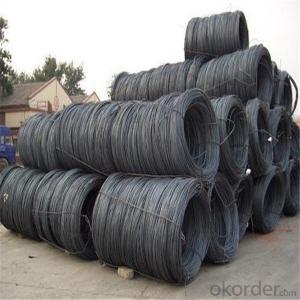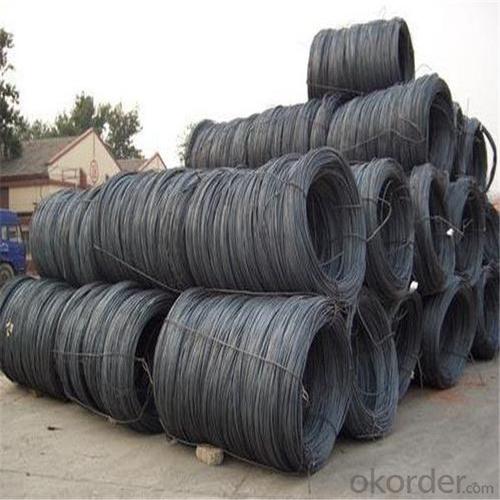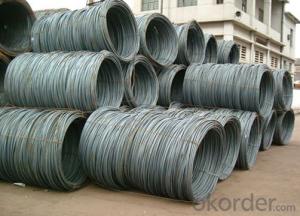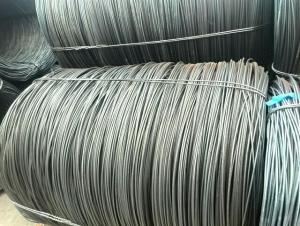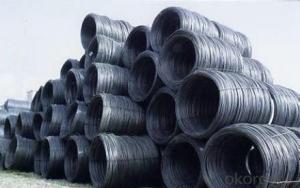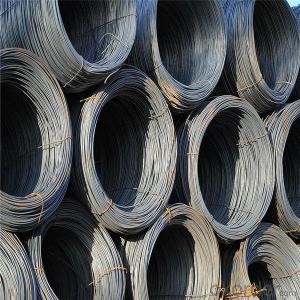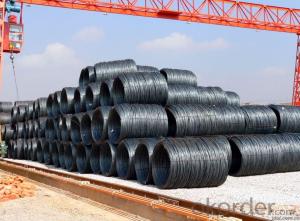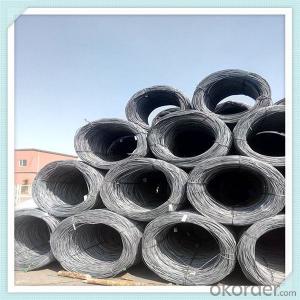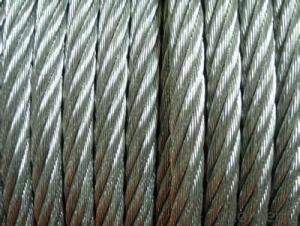Steel wire rod high carbon in different diamater
- Loading Port:
- Tianjin
- Payment Terms:
- TT OR LC
- Min Order Qty:
- 100 m.t.
- Supply Capability:
- 16532 m.t./month
OKorder Service Pledge
OKorder Financial Service
You Might Also Like
Specification
Drawing Grade wire rods are used by downstream industries for various applications such as making wires for
welded mesh, nails, hangers, screws, chain link & gabion fencing, wire nets, barbed wires and binding wires
Our Advantage: High quality steel products from 1 class mills in
Reasonable price
Professionalism of the products
On-time delivery
Complete documents and certificates
Sincere service to meet our clients' requirements
Product Description :
Standard | AISI, ASTM, BS, DIN, GB, JIS |
Material/steel grade | Q195-Q235,SAE1006B,SAE1006CR, SAE1008B, SAE1008CR, SAE1010B, SAE1018B, or according to customers requirements |
Wire Gauge | 5.5-12mm |
Coil weight | 1.8-2.1mts |
MOQ | 25MT |
Delivery Time | 15-30 days after receipt of L/C or deposit by T/T |
Packing | In coil and load in container, if large quantity, by bulk vessel; Can be packed as customers' special requirements |
Payment terms | 1).100% irrevocable L/C at sight. 2).30% T/T prepaid and the balance against the copy of B/L. 3).30% T/T prepaid and the balance against L/C |
Application | widely used in machinery parts, manufacturing industry, electronics industry, metal tools and others |
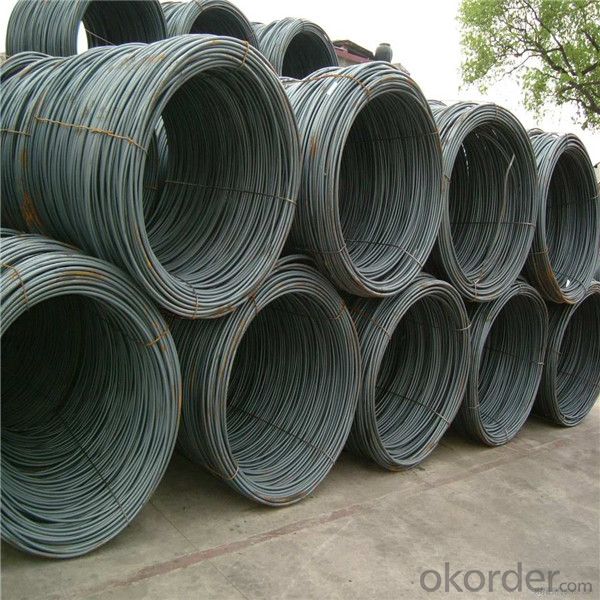
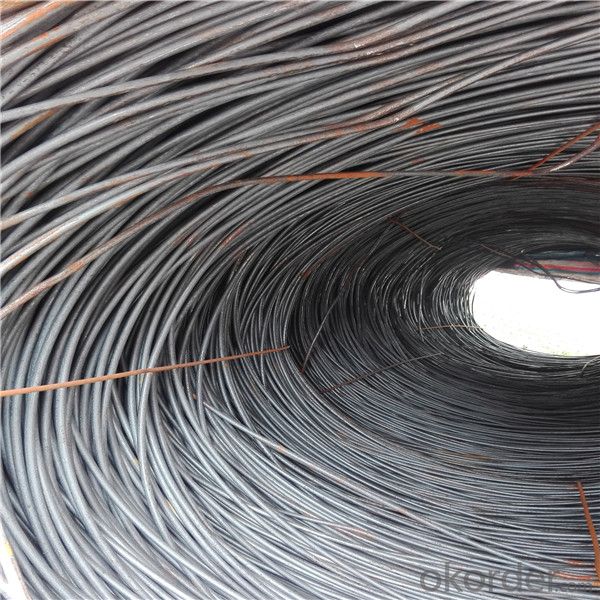

Application :
It generally used in braiding the hose for bathing product and machinery. With it
good flexibility, resistant to high temperature and resistant to corrosion, it
used widely in many industries.
Packing :
Hot-rolled wire rod is held in a unit with at least four steel straps in the
transverse direction and transported and stored without further packaging.
Before
the steel strapping is applied, the wire rod must be sufficiently compressed.
The strapping is fixed in the transverse direction with a single circumferential
strap so that the strapping does not slip and cause the coil to come apart.
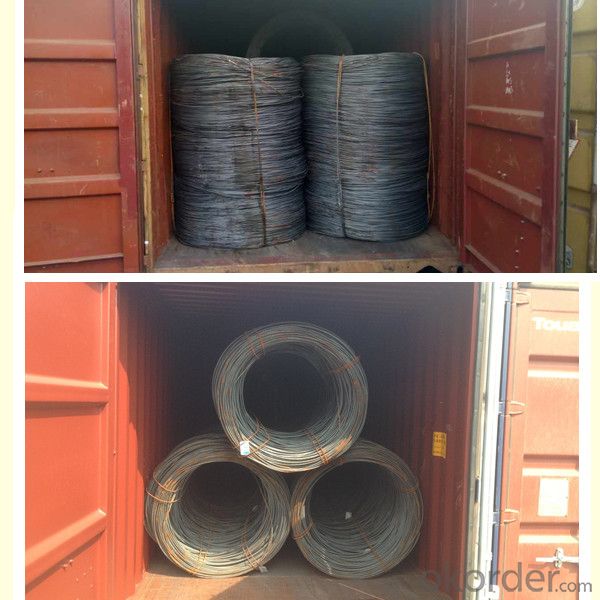
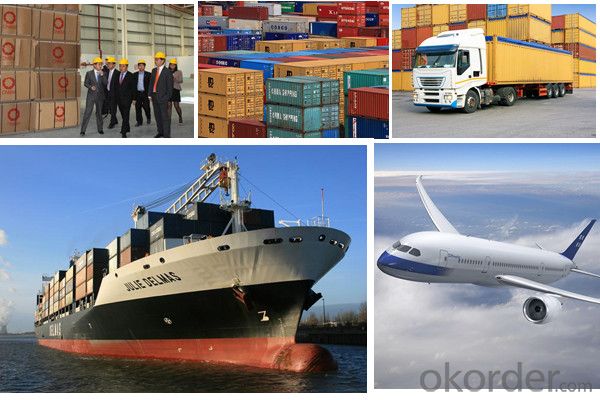
Our service:
(1) We cooperate with famous factories with advanced equipment and well trained workers.
(2) We can provide factory price with trading company service.
(3) We continuously work on the improvement of our processes, guaranteeing
consistently high standards of quality to keep none compensation.
(4) We guarantee 24 hours response and 48 hours solution providing service.
(5) We accept small order quantity before formal cooperation.
(6) We deliver the agreed quality at the agreed time, reacting to changes in
customer wishes in a flexible way.
(7) Due to our volume and selling power, we have excellent freight rates with
shipping lines.
(8) We strive to always be fair and honest in our dealings with customers.
(9) We strive to work together with customers to achieve much more than we can
achieve alone.
(10) Through our passion and commitment we aim to be a market leader in all our
key markets. To maintain our position as market leader we must continue to add
value in all that we do.
FAQ:
1.Q: What's your MOQ(minimum order quantity)?
A: One full container, mixed acceptable .
2. Q: What's your packing methods?
A: Packed in bundle or bulk ..
3. Q: How can I buy CNBM products in my country?
A:Please send us an inquiry or email ,we will reply to you if there is distributor in your country
4. Q: Can we visit your factory?
A: Warmly welcome. Once we have your schedule, we will arrange the
professional sales team to follow up your case.
5. Q: How long does it take to get the product if i place an order?
A:With the process of your requirements,we will pack and deliver in 3
-7 days. If it is by sea shipment,it will take 15-45 days depending on different locations
- Q: What are the different types of steel wire rod surface cleaning methods after wire drawing?
- There are several types of steel wire rod surface cleaning methods after wire drawing, including mechanical cleaning methods such as shot blasting, wire brushing, and sanding. Chemical cleaning methods like pickling and acid washing can also be used. Additionally, thermal cleaning methods like annealing and heat treatment can help remove impurities and improve the surface quality of the steel wire rod.
- Q: What are the different types of coatings for steel wire rod?
- Steel wire rods can be enhanced and safeguarded from corrosion through the application of various coatings. Some commonly employed coatings are as follows: 1. Zinc Coating: Galvanization, also known as zinc coating, is a highly favored option for steel wire rods. It ensures exceptional resistance against corrosion and can be applied using hot-dip galvanization or electroplating techniques. 2. Polymer Coating: Polymer coatings are often utilized to provide extra protection against corrosion and abrasion. These coatings can be applied through dip coating, extrusion, or powder coating methods, offering commendable adhesion and flexibility. 3. Phosphate Coating: Phosphate coatings are commonly employed as a pre-treatment for steel wire rods before the application of other coatings. They enhance the adhesion of subsequent coatings and improve corrosion resistance. 4. Epoxy Coating: Epoxy coatings are renowned for their exceptional adhesion and chemical resistance. They find frequent usage in industrial settings where the wire rods are exposed to harsh environments or corrosive substances. 5. Powder Coating: Powder coatings provide a robust and aesthetically pleasing finish to steel wire rods. These coatings are applied as dry powder and then cured under heat to create a smooth and protective layer. 6. Organic Coating: Organic coatings, such as acrylics or polyurethanes, are often employed for aesthetic purposes or to impart a specific color to the wire rods. These coatings also offer a certain degree of corrosion protection. 7. Ceramic Coating: Ceramic coatings find their application in high-temperature scenarios where the wire rods are subjected to extreme heat or thermal cycling. They exhibit excellent heat resistance and can withstand thermal shocks. It is crucial to select the appropriate coating based on the specific requirements and intended use of the steel wire rods. Different coatings provide varying levels of protection, durability, and resistance to specific environmental factors.
- Q: What are the different surface defects that can affect the machinability of steel wire rod?
- There are several surface defects that can affect the machinability of steel wire rod. Some common examples include cracks, pits, scratches, scale, and decarburization. These defects can reduce the performance and quality of machined parts and may lead to increased tool wear and decreased productivity.
- Q: How is steel wire rod used in the manufacturing of wire forms for ski lifts?
- Steel wire rod is used in the manufacturing of wire forms for ski lifts as it provides the necessary strength and durability required for supporting the weight of the ski lift cabins and passengers. The wire rod is typically shaped and formed into various components such as cables, ropes, and pulleys which are then assembled to create a secure and reliable system for transporting skiers up the slopes.
- Q: What are the different types of steel wire rod coating thicknesses?
- Depending on the specific application and requirements, there are various options available for coating thicknesses in steel wire rods. Some commonly used coating thicknesses are as follows: 1. Light Coating: This coating type involves the application of a thin layer of protective material on the steel wire rod. It offers minimal protection against corrosion and is suitable for environments or conditions that are not too harsh. 2. Medium Coating: With a thickness greater than that of a light coating, the medium coating provides a moderate level of protection against corrosion and other environmental factors. It is often chosen for applications where the wire rod may be exposed to moderate levels of moisture, chemicals, or abrasion. 3. Heavy Coating: A thicker layer of protective material is applied to the steel wire rod in this case. The heavy coating offers enhanced protection against corrosion, abrasion, and other harsh conditions. It is commonly used in applications where the wire rod will be exposed to extreme environments, such as marine or industrial settings. 4. Galvanized Coating: This type of coating involves the application of a layer of zinc on the steel wire rod. It provides excellent protection against corrosion and is commonly used in outdoor applications where the wire rod will be exposed to moisture and other environmental factors. When selecting the appropriate coating thickness for steel wire rod, it is essential to consider the specific requirements of the application. Factors such as the expected level of exposure to moisture, chemicals, abrasion, and temperature variations should be taken into account to ensure optimal performance and longevity of the wire rod.
- Q: What are the different types of steel wire rod finishes for improved solderability?
- There are several types of steel wire rod finishes that are commonly used to improve solderability. These include bare copper, tinned, silver-plated, and nickel-plated finishes. Each of these finishes provides a different level of solderability and corrosion resistance, allowing for a variety of options depending on the specific application requirements.
- Q: What are the different types of steel wire rod coatings used for anti-corrosion properties?
- Steel wire rod coatings are commonly used to prevent corrosion. There are various types of coatings available for this purpose. 1. Zinc Coatings: Zinc coatings, like galvanized coatings, are widely used for their anti-corrosion properties. These coatings create a protective layer of zinc on the steel wire rod surface, acting as a barrier against corrosion. Zinc coatings can be applied through hot-dip galvanizing or electroplating. 2. Aluminum Coatings: Another type of coating used for anti-corrosion is aluminum coatings. These coatings can be applied through hot-dip aluminizing or thermal spraying. They form a protective layer that prevents contact between the steel wire rod and corrosive substances. 3. Epoxy Coatings: Epoxy coatings, a type of organic coating, are commonly used for anti-corrosion purposes. They are applied as a liquid and then cured to create a hard and durable protective layer on the steel wire rod surface. Epoxy coatings offer excellent resistance against corrosion and can withstand harsh environments. 4. Polymer Coatings: Polymer coatings, such as polyethylene or polypropylene coatings, are frequently used for anti-corrosion properties. These coatings are typically applied through extrusion or powder coating. Polymer coatings provide a protective layer that is resistant to chemicals, moisture, and other corrosive elements. 5. Ceramic Coatings: Ceramic coatings are highly resistant to corrosion and wear. They are applied through thermal spraying or chemical vapor deposition. Ceramic coatings create a hard and dense layer on the steel wire rod surface, offering excellent protection against corrosion. Choosing the right coating depends on factors such as the environment, operating conditions, and desired level of corrosion resistance. Each type of coating has its own advantages and limitations, so it is crucial to select the most suitable one for long-term anti-corrosion protection of the steel wire rod.
- Q: What are the main factors influencing the choice of steel wire rod order product testing options?
- The choice of testing options for steel wire rod orders is influenced by several key factors. Firstly, quality control requirements play a vital role in determining the testing methods. Manufacturers and suppliers have their own measures in place to ensure that the products meet the required standards. These measures may include various types of testing, such as chemical composition analysis, mechanical property testing, and dimensional inspections. The specific testing options depend on the quality control requirements set by the manufacturer or customer. Another factor that heavily influences the testing options is customer specifications. Different customers may have specific requirements or preferences regarding the quality and performance of the product. For example, customers in the automotive industry may have strict specifications for the wire rod's tensile strength or ductility. In such cases, specialized testing methods may be necessary to meet these specifications. Industry standards also play a significant role in determining the testing options. Various industry organizations and associations establish standards and guidelines for the production and testing of steel wire rods. These standards ensure that the products meet the minimum requirements for safety, performance, and reliability. The choice of testing options is based on the specific industry standards that need to be met. Furthermore, regulatory compliance is a crucial factor that influences the choice of testing options. Steel wire rod manufacturers and suppliers must comply with the regulations and requirements set by governmental bodies or agencies. These regulations may include specific testing protocols to ensure the safety and quality of the products. The testing options are selected accordingly to meet these regulatory compliance requirements. In conclusion, the choice of steel wire rod order product testing options is influenced by quality control requirements, customer specifications, industry standards, and regulatory compliance. These factors guarantee that the products meet the necessary quality, performance, and safety standards set by manufacturers, customers, and regulatory bodies.
- Q: How is steel wire rod tested for resistance to erosion corrosion?
- Steel wire rod is tested for resistance to erosion corrosion through a series of specialized tests. These tests typically involve subjecting the wire rod to a corrosive environment, such as high-velocity flow of corrosive fluids or abrasive particles. The wire rod's resistance to erosion corrosion is evaluated by measuring factors like weight loss, surface degradation, or changes in mechanical properties after exposure to the corrosive environment. Additionally, advanced techniques like scanning electron microscopy and electrochemical methods may be used to further analyze the wire rod's resistance to erosion corrosion.
- Q: How is steel wire rod formed into specific shapes?
- Steel wire rod is formed into specific shapes through a process called wire drawing. In this process, the steel wire rod is passed through a series of dies, which progressively reduce its diameter and shape it into the desired form. The dies are typically made of carbide or diamond and are designed to exert pressure on the wire rod, causing it to elongate and take on the desired shape. This process allows for the production of various wire shapes and sizes, depending on the specific requirements and applications.
Send your message to us
Steel wire rod high carbon in different diamater
- Loading Port:
- Tianjin
- Payment Terms:
- TT OR LC
- Min Order Qty:
- 100 m.t.
- Supply Capability:
- 16532 m.t./month
OKorder Service Pledge
OKorder Financial Service
Similar products
Hot products
Hot Searches
Related keywords
